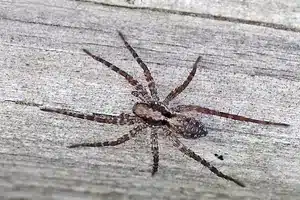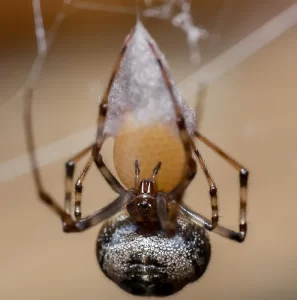
1. Common House Spider (Parasteatoda tepidariorum)
The Common House Spider was given that name for a reason. These house spiders in Ohio are very common because the females lay as many as a dozen egg cases, all containing hundreds of spiderlings. They can be found across the state, and they are known for their three-dimensional webs which are often seen on the upper corners of windows. Additionally, these brown spiders in Ohio can be found on the back sides of couches and chairs. The best way to prevent common house spiders is by making sure all windows have screens.
Color: Variable. Males are often brown or red in color. Females can be gray, tan, brown, or yellowish.
Eyes: Six eyes.
Size: Females 1/8 – 1/4 Inch. Males 1/8 Inch.
Adult Seasonality: May – September.
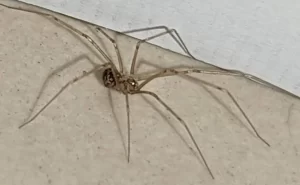
2. Long Bodied Cellar Spider (Pholcus phalangioides)
The long-bodied cellar spider is likely the spider responsible for the cobwebs in your basement. These house spiders in Ohio are also commonly mistaken for “daddy-long-legs,” however daddy-long-legs are not actually spiders. Additionally, these house spiders are more commonly found in commercial and residential structures. Finally, this daddy-long-leg lookalike is known to feed on large wolf spiders, despite wolf spiders being many times their size.
Color: Tan-colored body and legs.
Eyes: Eight eyes. Widely spaced lateral groups of three, with two in between.
Size: Females 1/4-3/8 Inch, Males 1/4-3/8 Inch.
Adult Seasonality: All year.
Related: Hornets in Ohio
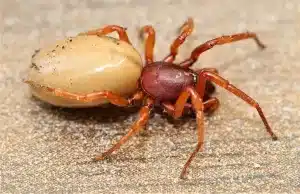
3. Woodlouse Hunter (Dysdera crocata)
The Woodlouse Hunter spider is a common house spider in Ohio. These guys are known for their very large fangs which make them quite intimidating to look at, however, they only bite when threatened. Common places Woodlouse Hunter spiders can be found are around foundations, basements, and moist cellars. Fun fact: The Woodlouse Hunter’s intimidating jaws are an adaptation for feeding on their main pre, the “pill-bug,” sometimes called “rolly-pollies” which have very hard exoskeletons.
Color: Red/rust-colored legs accompanied by a tan, bean-shaped sac. Large Fangs.
Size: Females 3/8 – 5/8 Inch, Males 3/8 Inch.
Eyes: Six Eyes.
Adult Seasonality: May – October.
Getting sick of creepy-crawly spiders around the house? Hire The Pest Detective to get a full-service treatment for spiders at an affordable price. (FREE Cobweb Removal!)
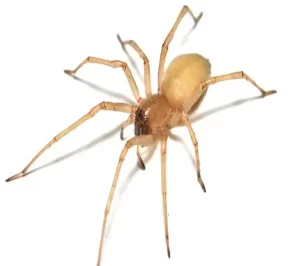
4. Yellow Sac Spider (Cheiracanthium mildei)
Believed to be introduced to Ohio from Europe, Yellow-Sac spiders are most commonly found inside houses and other man-made structures. These house spiders in Ohio are known to hide inside clothing, resulting in a bite when the clothing is worn. Yellow Sac spiders can also be found inside ceilings, corners of walls, and basements.
Color: Yellowish or pale green.
Size: Females 1/4 inch. Males 1/4 Inch.
Eyes: Eight eyes set in two rows of four.
Adult Seasonality: January – October.
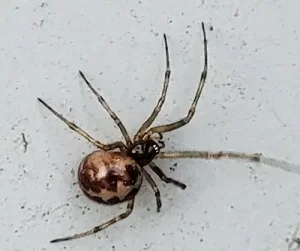
5. Checkered Cobweb Spider (Steatoda triangulosa)
This spider is one of the only spiders in Ohio that is strictly found inside homes, garages, and barns. The Checkered Cobweb Spider is often found near windows and doors hanging from a tangled web that looks similar to the web of a False Black Widow spider. Their food consists mostly of ants and other small insects. The egg cases are soft white and located in the webs of mature females, typically near a window. These Ohio brown spiders can be mistaken for the Common house spider in Ohio due to their similar appearance, however, Checkered Cobweb Spiders are more of a brown color.
Color: Yellow/ brown abdomen with a dark cephalothorax and angular markings on the back that sometimes create a checkered appearance.
Eyes: Eight eyes.
Size: Females 1/ 5 inch. Males 1/ 8 inch.
Adult Seasonality: May – December.
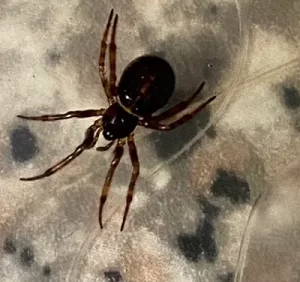
6. False Black Widow (Steatoda borealis)
False Black Widows are a very common spider inside homes in Ohio and they carry a strong bite that’s followed by excruciating pain. These brown spiders in Ohio hang upside down in a tangled cobweb which can sometimes cause people to mistake them for the poisonous Northern Black Widow. The key difference between the two is that it does not possess the red hourglass markings of the Black Widow in Ohio. This spider is often found inside basements, garages, and other buildings.
Color: Purplish-Brown.
Eyes: Eight eyes in a circular shape
Size: Females 1/ 4 – 3/ 8 inch. Males 1/ 8 – 1/ 4 Inch.
Adult Seasonality: All year.
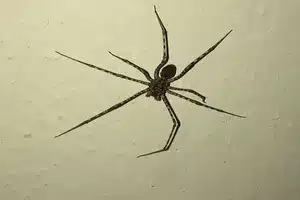
7. Spitting Spider (Scytodes thoracica)
Spitting Spiders in Ohio can be found within buildings and other man-made structures. They are particularly interesting because of the way they catch their prey. After finding a suitable victim, often another spider, they approach it slowly and forcefully shoot out a stream of glue from their fangs. This glue comes out so quickly that it looks like rapid-fire steam. The fangs vibrate in a zigzag manner to create a woven coat of the material over their prey, which pins the target to the wall in a Spiderman-like fashion.
Color: Cosmopolitan
Eyes: 6 eyes arranged in three sets of two
Size: Females 1/8 inch – 3/8 inch, Males 1/8 inch – 1/4 inch
Adult Seasonality: June – September
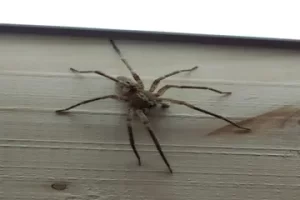
8. Common Crab Spider (Philodromus vulgaris)
The Common Crab spider, also known as the Long-legged Crab Spider, is a very common house spider in Ohio. Although it was once considered to be a part of the crab spider family, they are now considered distinct. These spiders have wonderful camouflage, allowing them to blend in well with tree bark and other debris within the woods. They are most commonly found in rural homes which are surrounded by trees or farmland.
Color: Gray / Bark texture
Eyes: 6 eyes
Size: Female 1/4 inch, Male 1/4 inch
Adult Seasonality: April – October
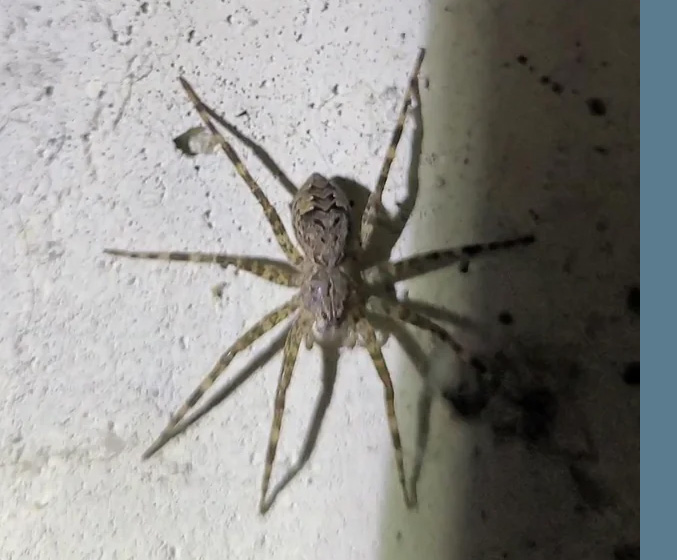
9. House Funnel Weaver (Tengenaria domestica)
House Funnel Weaver spiders in Ohio, also known as Tegenaria domestica, are commonly found in buildings but are seldom seen by residents. Funnel weaver spiders prefer hiding in cracks and secluded areas within homes, such as basements or garages. Their webs are unique, consisting of a sheet connected to a retreat by a funnel-shaped tunnel. As the spider matures, its web grows stronger and larger, with continual material additions. Interestingly, the House Funnel Weaver belongs to a genus of spiders known for a large species introduced to northwestern North America in 1930, known as Tegenaria agrestis. Many people assume that the specific name refers to aggression, but it does not. The name actually means “of the fields.” In the Seattle area, Tegenaria agrestis is considered a pest because it occasionally bites humans. However, the House Funnel Weavers in Ohio are not aggressive and do not usually bite humans. It is generally considered to be a harmless spider. Because this spider looks quite similar to T. agrestis, it generates many false reports of that species from Ohio, despite the fact that there are no valid records here. The house funnel weaver is also found in outbuildings, particularly barns. Another common name for this spider is barn funnel weaver.
Color: Tan / brown legs
Eyes: 6 eyes
Size: Female 3/8 inch, Male 1/3 inch
Adult Seasonality: All Year
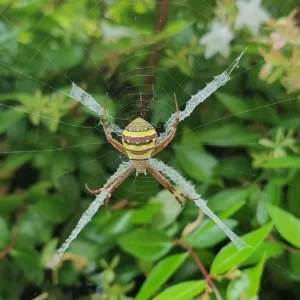
10. Cross Spider (Araneus diadematus)
Cross Spiders, or Araneus diadematus, are commonly found in Ohio and their existence in our region can be traced back to them being accidentally introduced to the US from Europe over 100 years ago. These Ohio spiders can be identified by their distinctive cross-shaped markings on their abdomen, they prefer outdoor habitats like gardens, bushes, and wooded areas. However, they can occasionally wander onto the sides of houses in northeast Ohio. These spiders are harmless to humans and play a beneficial role in controlling insect populations. Their webs are intricately woven and often found in areas with ample prey, such as near light sources or vegetation.
Color: Tan / Orange / White
Eyes: 6 eyes
Size: Female 3/4 inch, Male 1/2 inch
Adult Seasonality: September – October
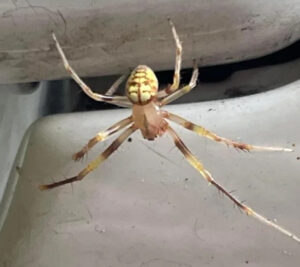
11. Arabesque Orbweaver (Neoscona arabesca)
The Arabesque Orbweaver in Ohio, or Neoscona arabesca, reigns as one of our regions most abundant orbweaver species. With a modest adult body length slightly exceeding ¼ inch, these spiders thrive in diverse habitats, from suburban yards and parks to woodlands and fields. Preferring to build their webs close to the ground, often among low shrubs or trees, Arabesque Orbweavers exhibit striking abdominal patterns, marked by thin black spots flanking the central design. While some sport plain hues, ranging from light brown to vibrant orange, their diurnal nature ensures visibility throughout the day, especially during the meticulous construction of their intricate orb webs. As they delicately add spiral threads to their webs, their movements evoke the grace of a ballerina, earning them the moniker “arabesque.”
Color: Light Brown/ Orange
Eyes: 6 eyes
Size: Female 1/4 inch, Male 1/4 inch
Adult Seasonality: July – October
Not seeing the spider you’re looking for? Maybe you should check out Wolf Spiders In Ohio, or continue on about Poisonous Spiders in Ohio!
Poisonous Spiders in Ohio
There is a diverse range of spiders in Ohio, with many playing an important role in maintaining an ecological balance. However, there are two types of poisonous spiders in Ohio that you should beware of: the Brown Recluse spider and the Black Widow spider. While both of these spiders are relatively rare in our state, they can still be encountered in certain habitats and pose potential risks to human health.
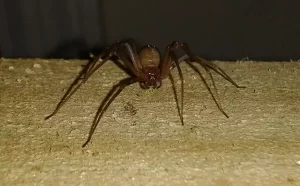
12. Mediterranean Recluse (Loxosceles rufescens)
The Mediterranean Recluse spider in Ohio is significantly more common than the Brown Recluse. These small and fuzzy poisonous spiders in Ohio have been found in several buildings throughout the state, however, they stand by their name and prefer to go unseen. Bites from these brown spiders of Ohio often occur when they are crushed which results in a defensive bite. A bite from the Mediterranean Recluse causes skin lesions and death of body tissue. There have been several reports of Staphylococcus aureus bacterial infections being misidentified as a bite from recluse spiders due to their similar appearance and damage to the body tissue.
Color: Brown
Eyes: Six eyes in three pairs that resemble a somewhat triangular shape.
Size: Females 1/4 inch, Males 1/4 – 3/8 inch.
Adult Seasonality: May – September
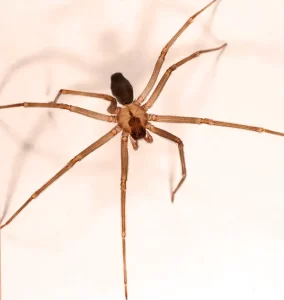
13. Brown Recluse (Loxosceles reclusa)
The brown recluse spider is one of only two poisonous spiders in Ohio, however, this house spider in Ohio is extremely rare and you would be lucky to run into one. Only nine out of 24,400 spider specimens recorded in Ohio have been confirmed to be brown recluse spiders, and they were all found inside houses or buildings. That’s because these brown spiders in Ohio prefer to hide in the dark places such as attics, cellars, and basements where they can blend in and go unseen. Like many house spiders in Ohio, the Brown Recluse Spider is known to hide under clothing kept on the floor, resulting in a bite when the clothing is worn. However, in most cases, the Brown Recluse Spiders in Ohio are found in abandoned buildings, unoccupied structures, and similar places with little to no human or animal activity. Some symptoms of an Ohio brown recluse bite include intense, burning pain in the area of the bite, red skin and/or allergic reaction, or an open sore caused by necrosis which develops a week or so after the bite if left untreated.
Color: Brown
Eyes: Brown recluse spiders have six eyes.
Size: Females 1/4 Inch, Males 1/4 – 3/8 Inch.
Adult Seasonality: May – September
Related: Will Bleach Kill Bed Bugs?
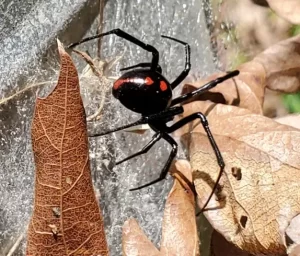
14. Northern Black Widow (Latrodectus various)
Despite how famous these spiders have become in our state, the Northern Black Widow in Ohio is exceptionally rare. However, if you happen to run into one of these highly poisonous spiders in Ohio you can effectively confirm its identity by looking for a red-orange hourglass shape located on the abdomen. Bites are rare, however, when they do strike it’s often when someone accidentally brushes up against their web resulting in a defensive bite. Like some other spiders in Ohio, they can be found hanging upside down on their web. Black widows are typically found in garages or barns as they prefer dry protected areas.
Color: Black with red-orange hourglass shape, sometimes split in two.
Eyes: Eight eyes, arranged in two rows of four.
Size: Females 1/4 – 3/8 inch. Males 1/8 – 1/4 inch.
Adult Seasonality: All year.
